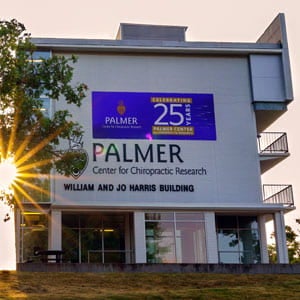We Reflect on the Rise of Chiropractic Research as we Celebrate the 25th Anniversary of the PCCR
 When Cynthia Long, Ph.D., PSTAT, dean of research at Palmer College of Chiropractic, first stepped foot onto campus as an employee 25 years ago, she never dreamed she’d be here for 25 years.
When Cynthia Long, Ph.D., PSTAT, dean of research at Palmer College of Chiropractic, first stepped foot onto campus as an employee 25 years ago, she never dreamed she’d be here for 25 years.
Now, as the Palmer Center for Chiropractic Research (PCCR) celebrates its 25-year anniversary, she can uniquely reflect on the rise of chiropractic research and its role in advancing the profession.
“Before 1995, Palmer and a number of colleges were conducting chiropractic research, but Palmer’s leadership decided to invest more heavily in research to expand and strengthen our work,” Dr. Long says.
“What’s unique about Palmer is that we took the most sustainable approach. Today we can look back and see that chiropractic research has influenced many realms of the profession, from curriculum, to practice, to the rise of multidisciplinary care settings and even policy. Palmer pushed the envelope by collaborating with high-level research institutions outside of chiropractic to grow and expand our research. Today that research is used profession-wide and beyond.”
Dr. Long was hired by then-director Iftikhar Bhatti, Ph.D., under the auspices of The Palmer Institute of Graduate Studies and Research. Shortly thereafter, William Meeker, D.C., M.P.H., now campus president at Palmer West, became the director of what is now known as the Palmer Center for Chiropractic Research.
“Chiropractic is a science, art and philosophy,” says Dr. Meeker. “Up until the early 90s, there was no ability for the profession to do research. Science is everybody’s tool and we should use it. We believed research would grow credibility toward our profession, and it has. It also impacted how we teach students so when they graduate, they understand how research impacts clinical care.”
Robert Vining, D.C., D.H.Sc., has worked for Palmer College for 12 years and now serves as the associate dean of clinical research. He leads research designed to inform practicing doctors of chiropractic, and most recently published a series of articles offering research-based tools that can help standardize language and streamline clinical assessment and care for low-back pain.
“The Palmer Center for Chiropractic Research is the most highly-funded chiropractic research center in the U.S.,” Dr. Vining continues. “The funding we’ve received is a direct indicator that researchers in other disciplines value the science we’re interested in and consider us capable of rigorously conducting studies and transparently reporting results. It also means that funding bodies such as the National Institutes of Health (NIH) understand that Palmer as an institution has dedicated, on an ongoing basis, financial, administrative, and logistical support necessary for conducting such research.”
The Palmer Center for Chiropractic Research has experienced many historical firsts. It became the first chiropractic institution to receive a grant directly from the federal government to establish a formal research center, was the first and only chiropractic institution to be awarded developmental center grants funded by the NIH, and was the first to receive NIH administrative supplement awards to support post-doctoral research training.
“Our alumni should be proud of their alma mater for being one of only a few colleges to have supported a critical mass of people to do basic science and clinical research,” says Dr. Meeker. “It takes money and support of a large, competent organization, and Palmer has done that consistently for the past 25 years.”
Milestones in PCCR History
Grants awarded in the early days enabled PCCR to build the foundation to conduct research.
1997: PCCR secured its first grant from the NIH.
2002: The NIH awarded PCCR a building grant, giving it the space, laboratories, and a dedicated research clinic needed to conduct high-level, relevant research, and accommodate requisite staff.
2007: PCCR was awarded the R25 grant which provided 10 years of funding to develop the faculty at Palmer’s three campuses. This grant was instrumental in providing the training and resources to incorporate evidence-based curriculum at Palmer.
Growing Chiropractic Research
After a decade of foundational research, PCCR developed increased capacity to conduct clinical research. The PCCR began to be awarded large-scale, multi-year grants to conduct research among larger populations. This research would ultimately influence curriculum, policy, and the growth of multi-disciplinary care.
2010: The assessment of Chiropractic Treatment for Low Back Pain, Military Readiness, and Smoking Cessation in Military Active Duty Personnel (ACT I, II, III) study was a collaborative project between the Samueli Institute, the RAND Corporation and PCCR, funded by the Department of Defense with $5.1 million granted to PCCR. This project spanned eight years and presented far-reaching implications for the health and productivity of our troops and the general public.
2019: PCCR is leading a $7 million, six-year study called VERDICT, in collaboration with the Yale Center for Medical Informatics, The Dartmouth Institute for Health Policy & Clinical Practice, and the University of Iowa. VERDICT is part of an $81 million federally-funded NIH-DoD-VA Pain Management Collaboratory, which is an initiative designed to support large-scale pragmatic clinic trials focused on the use of non-drug pain management approaches among active-duty and veteran populations. VERDICT will be carried out within four Veteran Administration clinics across the country.
PCCR Collaborations – Local and National
Projects are often a collective effort between scientists at the PCCR and collaborating investigators including physicians, chiropractors and scientists. During the past 10 years, the PCCR has collaborated with the following institutions:
Colleges and Universities: University of Iowa, Dartmouth College, Loyola University, Thomas Jefferson University, Yale University, Harvard University, Miami University, University of Kentucky, University of Pittsburgh.
Hospitals: Crotched Mountain Specialty Hospital and Genesis Health System.
Department of Defense: Active military at bases in Florida, California, Maryland, and Kentucky.
Veterans Health Administration: Iowa City, Iowa; West Haven, Connecticut; Minneapolis, Minnesota; and Los Angeles, California.
READ MORE from Palmer Proud Magazine

